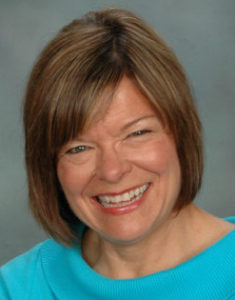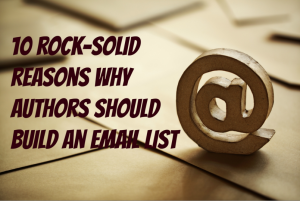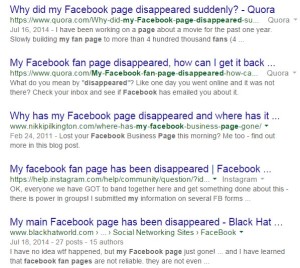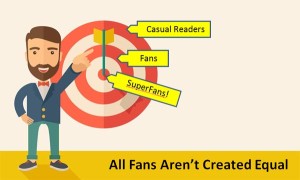10 rock-solid reasons why authors should build an email list
I have followed Joan Stewart for years and while we’ve spoken by phone, we didn’t meet in person until last spring when we both presented at a conference in Denver. We vowed to collaborate more going forward; this guest post is just the start of that. Joan, who is known as “The Publicity Hound,” works with authors, speakers and experts just like you who want to use free publicity to establish their credibility, enhance their reputation, and sell more books, products, and services. Learn more on her website and follow her her on Twitter at @PublicityHound.
10 rock-solid reasons why authors should build an email list
By Joan Stewart, The Publicity Hound
Two weeks before launching her book, the frantic author calls, begging me to help her identify every possible reader who might be interested in her book, and brainstorm ways to reach them.
One of my first questions always is, “Do you have an email list?”
“Only a list of family and friends,” she says. “But they’re sick of hearing about my book.”
When that scene repeats itself every few weeks, my heart breaks.
Without an email list of people who have raised their hands and given you permission to market to them, you’re leaving thousands of dollars, as well as stacks of unsold books, on the table.
Email: A profitable power tool for authors
After building two email lists for more than 15 years – one with 7,000 names in my shopping cart and one with 6,300 names in AWeber, my email management program, I can’t think of a marketing tool that comes anywhere close to making money faster than email does.
Tim Ferriss, author of The 4-Hour Work Week, built a list of more than 250,000 fans but did nothing with it for three years. When he finally started emailing regularly, he realized that he had been “sitting on Fort Knox.”
Your list doesn’t have to be as big as his, or even as big as mine. A small list of just a few hundred fans can reap dividends if you mail interesting content on a regular schedule. Don’t start building a list but delay mailing because you “don’t have enough names.” I started with only one.
If you haven’t written your book yet, you’re in a much better position than the author above who’s launching in two weeks. You have time to build your list and give readers a chance to know, like, and trust you.
Here are 10 rock-solid reasons why you should start building a list now, regardless of your genre and whether you write fiction or nonfiction.
1. Email can be your secret weapon.
At least nine out of 10 authors don’t market with email. Maybe it’s because so many authors are introverts and just want to be left alone to write books.
That means huge potential to attract a solid list of fans who are interested in your topic and hungry for your content. Why? Because so few authors are providing it.
2. It’s inexpensive.
Don’t believe what you hear about needing a big email list. A small list of several hundred loyal fans who love you can be much more valuable than a list of 50,000, most of whom might not bother opening your emails.
My AWeber program costs only $69 a month to email as often as I wish to about 6,300 people who subscribe to my free email tips on publicity. I also clean my list regularly, which means I remove people who don’t open my emails within six months. Why pay to mail to someone who isn’t interested?
If you don’t have a budget, you can use the free version of easy-to-use MailChimp, until your list grows and you need the paid version. Or you can switch to AWeber which has an A+ help desk with phone support.
3. You’ll have a ready-made list of fans in place before you launch — and you own the list.
Even with a list of only a few hundred, you can convince some of them to let their friends and followers know about your book. The more valuable your content, the more eager they will be to help you. Authors who don’t have email lists are at a huge disadvantage on launch day.
If you have a big following on Facebook, relying solely on social media can be dangerous because you don’t own the property. Do a Google search for “my Facebook fan page disappeared” and you’ll see how many people, some of them authors, have lost thousands of fans that took years to attract.
4. It’s the fastest, most efficient way to communicate with a big group of fans.
OK, so you’re on Facebook. Not all your fans are, however. Same with Twitter, LinkedIn, Instagram, Pinterest, Google+, and other social media sites. Think about how much time you spend sharing one piece of content to multiple sites. And how little traction you build.
In less than 20 minutes, you can send one well-written email message about a special promotion you’re running and watch your Amazon numbers change.
If subscribers decide they don’t want to receive your emails, they can click the “unsubscribe” link without bothering you. If they do ask you to unsubscribe them, do it, and don’t try to change their minds.
5. You can send follow-up messages automatically to build the relationship.
If you want to see how this works, grab my free cheat sheet “10 Profitable Ways to Use Email to Create SuperFans Who Help You Sell Books.” (Note from editor: That offer is no longer available, so we’ve removed the link.)
Over the next several days, you’ll receive a series of four email messages, asking you for feedback on my tips. The emails are so short and simple–without photos or fancy fonts–that many authors thank me for responding. Some think I wrote the plain text emails only for them because they look exactly like the emails their family and friends send. Save the fancy templates for your newsletter.
6. You can separate your fans by what interests them.
This means that if you’re using a decent email management program, you can place subscribers onto separate lists according to where they live, their occupation, products purchased, or other criteria. By doing this, you can email all your fans in, say, Boston, to let them know you’ll be doing a book signing at a Boston bookstore. You don’t have to pester the hundreds of other people on your list who don’t care about that event.
You can also send an entire series of follow-up messages to just one segment. Segmenting readers is a powerful tool if you’ve written books on unrelated topics.
7. You can convert casual observers on your list into a smaller circle of loyal fans, and those loyal fans into a smaller but more valuable circle of what I call SuperFans.
Kevin Kelly, the founding executive editor of Wired magazine, writes about the importance of SuperFans or what he calls “True Fans.” These are people who can’t stand to be without anything you produce.
Here’s an excerpt from the book The Curve: From Freeloaders Into Superfans by Nicholas Lovell.
“A creator, such as an artist, musician, photographer, craftsperson, performer, animator, designer, videomaker, or author–in other words, anyone producing works of art–needs to acquire only 1,000 True Fans to make a living,” Kelly writes.
“They will drive 200 miles to see you sing. They will buy the super deluxe re-issue hi-res box set of your stuff even though they have the low-res version. They have a Google Alert set for your name. They bookmark the eBay page where your out-of-print editions show up.
“They come to your openings. They have you sign their copies. They buy the T-shirt and the mug, and the hat. They can’t wait till you issue your next work. They are true fans.”
And they make the cash register go ka-ching, ka-ching.
8. You can interest people in your topic, and give them time to know, like, and trust you before you ask them to buy anything.
If you follow the 80-20 rule of marketing – share 80 percent valuable or interesting content and 20 percent promotions – you can’t go wrong.
What’s valuable content? How-to tips, stories, information about emerging trends, helpful tools you love using, writing tips, and even step-by-step instructions on how to do something.
An author who writes horror novels can show people how to make a Halloween mask that resembles a character in the book. A romance author can explain how singles can have fun on Valentine’s Day without a significant other. The author of poetry books can share a “Top 10” list of websites for readers who want to try their hand at writing poetry.
9. If you blog, you can send a “blog broadcast” to your email list whenever you publish a new post, or you can send a weekly wrap-up of links to your posts.
I don’t do this but some of my author clients do. I love the idea because it encourages them to blog on a regular basis. And they don’t have to rely only on the search engines to pull traffic to their blogs.
10. Fans who love you on social media, but see your content sporadically, can subscribe to your email list so they don’t miss a beat.
Content you publish to Twitter, LinkedIn, and Facebook can drop far down in someone’s feed within minutes. If they aren’t in front of their computers when you publish it, they can miss it. Email, on the other hand, stays in their inbox until they delete it.
Have I convinced you?
If you’re thinking about writing a book, or if you’ve already published, start building an email list now.
What questions do you have about email marketing? Do you use it? If so, what results have you seen? Share your questions and success stories in the comments.
Like what you’re reading? Get it delivered to your inbox every week by subscribing to the free Build Book Buzz newsletter. You’ll also get my free “Top 5 Free Book Promotion Resources” cheat sheet immediately!





Joan – thanks for these specific techniques on how to get and hold an e-mail audience. Social media is hit-and-miss (go away quickly, short attention span) while e-mail can draw in the reader for more in-depth details.
Exactly, Virginia. Social media is also “scattered” with tweets here, Facebook posts there, and LinkedIn groups everywhewre. An email list is a handy receptacle where you can consolidate all your fans in one place and communicate with them whenever you wish.
I don’t need why. I need how to get them to sign up that actually works (yes, I’ve done all the usual things, and none of them have worked).
There are a few simple things you can do to help (assuming you host your own blog and can implement them). Joan’s ideas are the best basics (I offer a list of other websites in my niche genre), but then it’s about marketing.
I’ve learned the most from CopyBlogger (CoSchedule is another to check out); experimenting with a super short call to action (didn’t work at all) and then an impassioned long form page of *why* we need what I offer. Combine this with calls to action with power words (for me “ultimate guide”), a big front page banner, bottom of post reminder, and a simple click popup.
Plus, I don’t ask my people to do anything else. If they scroll way to the bottom they’ll find my social media accounts, but the only other action they can take besides signing up is sharing so their friends find out about me.
Doing this has helped my list go from growing c.15 emails a month to around 60 without me having any opportunities to speak!
I write fiction, so the calls to action as you phrase them are not practical. Other than that, I’ve pretty much done what you’ve said. Nada.
M.M., here are three ways to encourage people to sign onto your list:
–Offer a killer digital freebie, also known as a “lead magnet.” Think beyond an ebook. It can be links to a series of short videos. Or a one-page cheat sheet like the one I offered in the post above. People also love checklists, how-to guides, step-by-step instructions on how to solve a problem, and Top 10 lists.
–Collect email addresses at public speaking engagements. If you don’t speak yet, get onto the speaking circuit! This is how I collected almost all my emails when I started my business.
–Email on a regular schedule and encourage people to recommend your email list to their LinkedIn Groups, friends who need the same kind of advice, etc. If they love your content, they’ll be happy to spread the word.
Good luck.
I don’t do speaking engagements, alas (you don’t *want* me to, trust me). I’ve done the freebie to no avail, and if there’s no one on the email list to start with, sending emails isn’t much use.
So true, Joan. It’s encouraging to know if I take the time to do this it is already putting me at an advantage. In fact, I just started realizing how unusual having a strong web presence is yesterday when I wanted to network with some authors in my field. They aren’t *anywhere* online, so I can’t even say thank you.
Having an email newsletter is an exciting thing as a reader, as well as being good for me as an author. It’s a win/win!
Thanks, Cherie. I’m surprised those authors didn’t have websites. How established/known are they?
Sandy
I’m with Sandra. How can an author hope to sell anything without a website?
Thankyou for the informative words. Time to build up my email list before I launch the trilogy. This is my first venture into the publishing world. Written many short stories over the years for the Writer’s Group I attend twice a month. Wonderful Authors who read and critique. Without their encouragement I doubt I would have had the courage to write a Science Fiction Trilogy. At this moment book 1 is in the capable hands of an Editor.
Linda, congratulations on taking a giant step in the world of publishing. I wish you the best and hope your trilogy flies off the shelves.
These are all great reasons to have an email list. I’ve built up a list for my non-fiction readers and I can say that it works just as well as for fiction! Email newsletters are an important part of my marketing, as I can find out what my readers want, share their challenges / successes, and be (hopefully) front of mind when they come to buy a book. I make sure to answer all emails – I love hearing from readers and of course it also builds a good relationship.
I’d also like to add that email marketing / newsletters also help authors to gain the repeat views that are necessary in order to make sales. Marketing experts tell us that buyers need 7 of these contacts before they will buy. But as most website visitors are “unique” and never return, that means that they’re unlikely to ever buy just from visiting our site. Email gives us those increased points of contact – resulting (in theory) in a greater number of sales.
Clare, I’m thrilled that you mentioned one of the big benefits of email marketing that I didn’t mention: the ability to repeat your message over and over again.
If it’s true that buyers need to see a marketing message seven times before they buy, and I believe it is, you could repeat your message seven times in just seven weeks with a weekly newsletter.
My email list is very short (mostly friends and family, and a few fans) I do have a larger list of friends on my Facebook pages, but my attempt to get them to add their email addresses to my newsletter list(yes,I have started one)has failed totally. I’m a fiction author with three books out (not a series, I’m sorry to say.)I find that most of what is written about email lists applies to non-fiction. Do you have source material on list-building specifically for fiction writers?
Ed, everything in this post applies to both fiction and nonfiction, and most of what you’ll find elsewhere about list-building for authors that seems to apply to nonfiction will also apply to fiction. You might have to make a little extra effort to view it through a fiction lens, but it applies. For example, all authors looking to build an email list should have an opt-in form on their website and a free bonus download that will appeal to their target audience. Then they need to communicate regularly with their list in a way that isn’t always overtly selling the author’s latest book. Back to that free download that will entice fans to give up their email address, here’s a link with more info — it’s specific to fiction: http://buildbookbuzz.com/reader-magnets/ .
Sandy